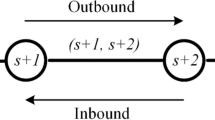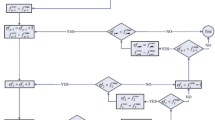Abstract
The objective of designing timetables for public transportation is twofold: to ensure an efficient use of limited resources and to provide a comfortable ride for passengers. Two models for timetable optimization are investigated in this study. Model 1 uses a crisp constraint on the rate of vehicle capacity usage. Model 2 improves on model 1 by translating the crisp constraint into a fuzzy goal representing passenger satisfaction, and a fuzzy constraint, representing the extent of vehicle usage. Both, the fuzzy goal and the fuzzy constraint, are fuzzy sets on the number of on-board passengers. Heuristic methods together with linear programming are proposed for finding the optimal headway. Model 1 selects the largest time interval under the bound on vehicle size. The set of optimal time intervals in model 2 is decided by the simultaneous level cuts of the fuzzy goal and constraint. Experimental results show that fuzzy-set based model 2 is the most flexible and effective way to generate an optimal timetable.






Similar content being viewed by others
Notes
In China, \(\mathcal {B}\) is defined very precisely as the number of seats plus the effective standing area on the bus(sq.m.) times 8 (this assumes that up to 8 people can stand on a square-meter surface).
References
Bellman, R. E., & Zadeh, L. A. (1970). Decision-making in a fuzzy environment. Management Science, 17(4), B-141.
Castelli, L., Pesenti, R., & Ukovich, W. (2004). Scheduling multimodal transportation systems. European Journal of Operational Research, 155(3), 603–615.
Ceder, A. (1984). Bus frequency determination using passenger count data. Transportation Research Part A: General, 18(5–6), 439–453.
Ceder, A. A., Hassold, S., & Dano, B. (2013). Approaching even-load and even-headway transit timetables using different bus sizes. Public Transport, 5(3), 193–217.
Chaari, T., Chaabane, S., Aissani, N., & Trentesaux, D. (2014). Scheduling under uncertainty: Survey and research directions. In 2014 International conference on advanced logistics and transport (ICALT) (pp. 229–234). IEEE
Chakraborty, D., Guha, D., & Dutta, B. (2016). Multi-objective optimization problem under fuzzy rule constraints using particle swarm optimization. Soft Computing, 20(6), 2245–2259.
Chakroborty, P., Deb, K., & Subrahmanyam, P. (1995). Optimal scheduling of urban transit systems using genetic algorithms. Journal of transportation Engineering, 121(6), 544–553.
Choon, O., & Tilahun, S. L. (2011). Integration fuzzy preference in genetic algorithm to solve multiobjective optimization problems. The Far East Journal of Mathematical Sciences, 55, 165–179.
Desaulniers, G., & Hickman, M. D. (2007). Chapter 2 public transit. Handbooks in Operations Research and Management Science, 14, 69–127.
Domschke, W. (1989). Schedule synchronization for public transit networks. OR Spectrum, 11(1), 17–24.
Goyal, R. K., & Kaushal, S. (2018). Deriving crisp and consistent priorities for fuzzy AHP-based multicriteria systems using non-linear constrained optimization. Fuzzy Optimization and Decision Making, 17(2), 195–209.
Guihaire, V., & Hao, J. K. (2008). Transit network design and scheduling: A global review. Transportation Research Part A: Policy and Practice, 42(10), 1251–1273.
Hassold, S., & Ceder, A. (2012). Multiobjective approach to creating bus timetables with multiple vehicle types. Transportation Research Record: Journal of the Transportation Research Board, 2276, 56–62.
Ibarra-Rojas, O., Delgado, F., Giesen, R., & Muñoz, J. (2015a). Planning, operation, and control of bus transport systems: A literature review. Transportation Research Part B: Methodological, 77, 38–75.
Ibarra-Rojas, O. J., López-Irarragorri, F., & Rios-Solis, Y. A. (2015b). Multiperiod bus timetabling. Transportation Science, 50(3), 805–822.
Kaymak, U., & Sousa, J. (2003). Weighted constraint aggregation in fuzzy optimization. Constraints, 8(1), 61–78.
Ramík, J., & Vlach, M. (2016). Intuitionistic fuzzy linear programming and duality: A level sets approach. Fuzzy Optimization and Decision Making, 15(4), 457–489.
Salicru, M., Fleurent, C., & Armengol, J. (2011). Timetable-based operation in urban transport: Run-time optimisation and improvements in the operating process. Transportation Research Part A: Policy and Practice, 45(8), 721–740.
Sun, D. J., Xu, Y., & Peng, Z. R. (2015). Timetable optimization for single bus line based on hybrid vehicle size model. Journal of Traffic and Transportation Engineering (English Edition), 2(3), 179–186.
Sun, L., Jin, J. G., Lee, D. H., Axhausen, K. W., & Erath, A. (2014a). Demand-driven timetable design for metro services. Transportation Research Part C: Emerging Technologies, 46, 284–299.
Sun, L., Tirachini, A., Axhausen, K. W., Erath, A., & Lee, D. H. (2014b). Models of bus boarding and alighting dynamics. Transportation Research Part A: Policy and Practice, 69, 447–460.
Tang, J., Wang, D., Fung, R. Y., & Yung, K. L. (2004). Understanding of fuzzy optimization: Theories and methods. Journal of Systems Science and Complexity, 17(1), 117–136.
Tilahun, S. L., & Ong, H. C. (2012). Bus timetabling as a fuzzy multiobjective optimization problem using preference-based genetic algorithm. Promet-Traffic and Transportation, 24(3), 183–191.
Wong, R. C., Yuen, T. W., Fung, K. W., & Leung, J. M. (2008). Optimizing timetable synchronization for rail mass transit. Transportation Science, 42(1), 57–69.
Zadeh, L. A. (1965). Fuzzy sets. Information and Control, 8(3), 338–353.
Acknowledgements
Yanan Zhang’s work for this study was supported by the China Scholarship Council (Grant No. 201506250051) while visiting the MLCI Laboratory led by Anca Ralescu, in the EECS Department, College of Engineering and Applied Science, University of Cincinnati.
Author information
Authors and Affiliations
Corresponding author
Rights and permissions
About this article
Cite this article
Zhang, Y., Meng, Z., Zheng, Y. et al. Schedule optimization under fuzzy constraints of vehicle capacity. Fuzzy Optim Decis Making 18, 131–150 (2019). https://doi.org/10.1007/s10700-018-9289-0
Published:
Issue Date:
DOI: https://doi.org/10.1007/s10700-018-9289-0




